Most rebrands begin with a ton of excitement – a name is announced, timelines are discussed, and work starts to move forward. But often, that momentum outpaces the planning.
Teams start assigning tasks, pulling vendor quotes, and building timelines. What’s often missing is a foundational plan that accounts for everything the rebrand will touch and how it all needs to come together.
That’s where things start to slip. Costs creep up. Deadlines shift. And the budget that gets set later in the process is already under pressure before it’s even approved.
The challenge isn’t effort, it’s structure
Most organizations simply aren’t built to manage a rebrand internally.
They have the right talent, brand, marketing, operations, and lack the systems, cross-functional alignment, or benchmarking data to drive a rebrand from end to end.
So instead, they rely on individual teams to make it work. One group reaches out to vendors. Another starts updating templates. Another manages signage. All with the best intentions and without a centralized view.
What looks like progress is actually duplication, delays, and unintended spend.

A real-world example: Bristol Myers Squibb
When Bristol Myers Squibb began planning their rebrand, they expected to manage the process internally. They had scoped the work, outlined their approach, and developed a budget based on early vendor conversations.
But when they brought us in to pressure-test their plan, we could see some of the numbers were off.
Through a strategic review, we helped refine their implementation approach, consolidate vendor scope, and recalibrate spend based on actual asset volume and complexity.
The result?
A stronger, more scalable rollout plan
- Vendor costs reduced by 34%
- Final signage spend of $5.7M, down from a projected $15M
- No meaningful scope reduction
Because the plan was grounded in operational reality, it held up and created room to reinvest in higher-value brand and marketing work.

A rebrand is an investment
Whether your brand change is the result of a merger, repositioning, or growth strategy, it’s a significant investment. And like any investment, it requires structure, modeling, and governance to deliver ROI.
| Scenarios Client Evaluated | ||
|---|---|---|
| Client Sector | Low | High |
| Healthcare, $8B | $27M | $37M |
| Healthcare, $16B | $56M | $78M |
| Pharma, $48B | $54.2M | $82.3M |
| Pharma, $64B | $53.5M | $125.3M |
| Financial Services, $74B | $29M | $81.4M |
| Banking, $24B | $701M | $823M |
| Manufacturing, $2B | $26M | $29M |
| Energy, $11B | $13.9M | $28.7M |
| Professional Services, $5B | $7M | $13.9M |
| Higher Education, $5B | $39M | $49.9M |
| Technology, $1B | $2.3M | $10.6M |
| Logistics, $193M | $12.5M | $26M |
Let’s make sure your plan holds up
If your rebrand is underway, or still in early planning, now is the right time to take stock.
We can help you pressure-test your assumptions, model rollout scenarios, and bring clarity to your operational plan before costs start adding up.
Let’s talk. Even a short conversation can help you avoid the most common pitfalls and make your rebrand spend work harder.
